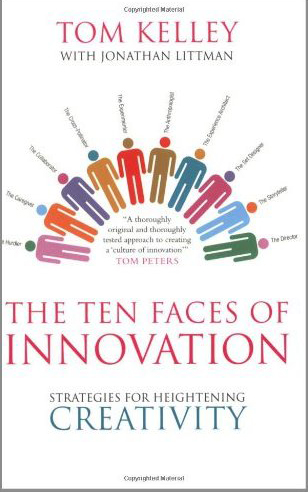The Ten Faces of Innovation
The Ten Faces of Innovation is a book by Tom Kelly, based on IDEO's way of design thinking. IDEO is a design and innovation consulting firm. The book shows how industrial designers have to play multiple roles in the design process and there are ten different faces involved. After reading this book a few years ago, I started a summary. Here is a short summary of three chapters in the book. If this sounds interesting, you may purchase the book on Amazon, or try and find it at a local library. It's pretty worthwhile to read if you're interested in design.

Anthropologist
When playing the role of the anthropologist, for instance, the industrial designer goes into the user’s environment and observes, gather information, and ask questions. This role may be played before the rest of the design process and in the middle of the design process to gather information about the user. This is important in the design process because a designer who simply generalizes from his or her own standards will be limited in what he or she can produce. The best way to receive accurate information from users about a product use or experience is through observation such as staying in an office setting and observing the behavior of the people sitting in chairs. The observer should be unobtrusive so as to gather more accurate behavior. Some anthropologists may bring cameras and film a setting, then play the film many times. When asking questions it may be best to ask open ended questions where people may not try to guess an expected response. It is the anthropologist’s job to gather information about what people do and don’t do, say and don’t say to know what the user desires, as it may be hard even for users to know exactly what they want or need.
Experimenter
The experimenter is needed to make sketches, models or prototypes of a product idea, test them and make improvements. Many models may be tested. For instance, a British entrepreneur named James Dyson who is known for making Dyson vacuum cleaners built 5,127 unsuccessful prototypes of his cyclone vacuum before he created the design that made him a billionaire. Not all experimentation has to be this exhaustive but the experimenter should have the passion for hard work, have an open mind, and not give up in the face of failed attempts. There is a saying from IDEO that states, “Fail early to succeed sooner.” This should be the attitude of the experimenter.
Cross-Pollinator
They can create new and better things through unexpected combinations of seemingly unrelated ideas or concepts. These are the people who take pleasure in learning and collecting knowledge by taking notes on what they learn to increase the amount they can retain, and pass on what they learn to others. They are able to see patterns others don’t and spot differences, then put them in new contexts. They look at history as well as science fiction for opportunities. They are T-shaped people who have knowledge in many fields but specialized knowledge in one area. Constraints like limited resources, to them, open doors to great innovations. “Like poets working with meter and rhyme, great Cross-Pollinators seek out constraints.” They keep an open mind and know that success can come from unlikely directions.
